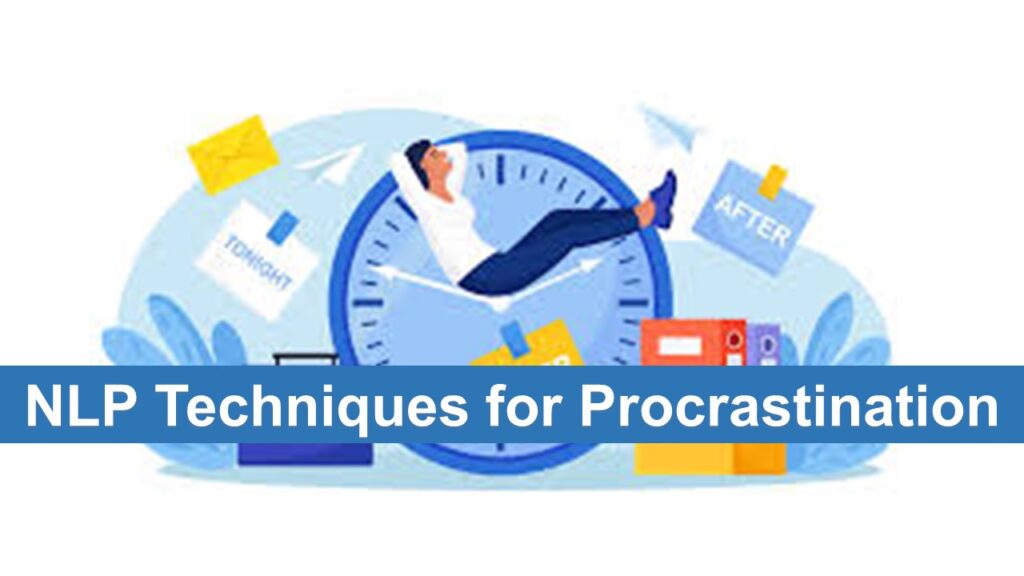NLP techniques for procrastination will cover technique, process, and more in this short blog.
Procrastination is a complex problem that varies from person to person.
One can be lazy at a certain point of time, place and situation, so first we need to understand the reasons behind procrastination.
NLP is the method of the language with which we shape our ideas, thoughts, feelings and behavior. These NLP techniques for procrastination will definitely help us understand the problems and resolve them accordingly.
What is Procrastination?
As per Verywell-mind, Procrastination is the act of delaying or putting off tasks until the last minute or past their deadline.
Surprisingly, we are aware that procrastination will affect us negatively, still we keep things pending until the deadline.
It is more of a self regulation issue than time management issue, with the help of NLP techniques for procrastination, we can be more productive.
📘 Practical Applications of Neuro Linguistic Programming (9 book series)
Want ready-to-use NLP patterns at your fingertips?
👉 Grab your copies Now
What are NLP techniques for procrastination?
Here are some of the NLP techniques for procrastination we can use.
NLP Presuppositions
There are 13 NLP presuppositions that can be useful to understand the reason behind the procrastination behavior.
“Every behavior has some positive intention.” – you can utilize this NLP Presupposition will be helpful to understand your procrastination.
Try to identify what positive outcome or behavior we are achieving with procrastination.
Identify if you can get that positive behavior with avoiding procrastination, or can you emphasize on other benefits that can be better.
NLP Reframing
NLP Reframing techniques give another perspective to internal dialogue we have for procrastination.
You can use NLP Reframing to rest and recharge, changing the perspective towards the procrastination behavior.
You can reduce feelings of guilt and shame associated with the behavior and can be changed into something motivating to complete the tasks at hand.
NLP reframing gives new meaning to the self-talk we do, it can be useful to get rid of procrastination.
Mapping Across NLP
Mapping across NLP technique can literally change the behavior from dislike to like, not this but that.
For successful mapping across NLP process, you need to understand the representational systems at work while you are procrastinating.
Imagine the situations, where you exhibit this behavior mostly, elicit all the submodalities for that behavior.
Now Imagine the situations, where you are most productive and get things done in jiffy, elicit all the submodalities for this behavior also.
Find out the differences in both behavior submodalities and do the changes with help of your notes.
You can read my detailed blog from here on mapping across NLP.
NLP Swish pattern
NLP Swish pattern is one of the best NLP techniques for procrastination, it is largely used to make new behavior in subject.
Imagine yourself procrastinating and take a picture of that, now imagine yourself as a productive person and make a small picture of that also.
Now put your productive image in the corner of the large unproductive image.
Now quickly imagine a productive image is taking over an unproductive image and turns into a blank state in the end.
I have created a detailed post about NLP Swish pattern with script, you can refer to for detailed instructions.
NLP Dickens Pattern
When it comes to visualization, I prefer the NLP Dickens pattern, it allows you to see behavior from 3 perspectives.
NLP Dickens pattern is performed remembering past, observing present and assuming future, keeping the problem behavior at the center.
Imagine yourself procrastinating from the past, see what you saw, hear what you heard and try to feel what you felt. Imagine what your past self will suggest about your inaction.
How is it affecting your present? Is it something you desire for? What changes can you make in the present to prevent your future?
Imagine you have not made any changes, what will be your future? What will your future self tell you to change? Can you make that change in the present?
NLP Dickens pattern is one of the powerful NLP techniques for procrastination.
NLP Anchoring technique
NLP Anchoring technique can be used to relive the positive behavior again and increase your productivity.
If you can identify certain events that cause procrastination, you can use the Anchoring technique to face them properly.
Imagine yourself when you were very productive, see yourself in a picture or movie being productive, expand that image you may increase intensity or anything that makes you feel more powerful and productive.
Once the imagination is at its peak, choose a unique spot on your body to touch and store that feeling.
After taking a break, test that anchor, whether you feel productive or not. If nor repeat the process or find a more powerful image to try again.
Read my blog on NLP Anchoring techniques here for detailed guidance and better results.
When you are trying these NLP Techniques for procrastination? Keep me posted.
